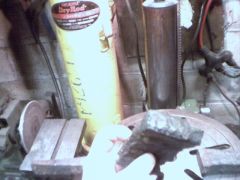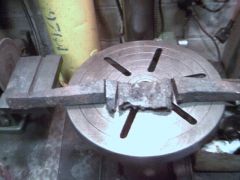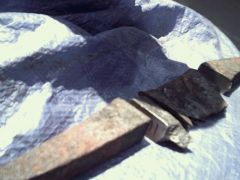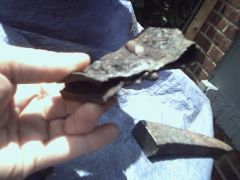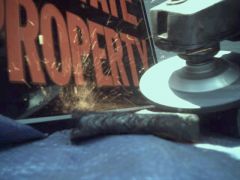-
Posts
117 -
Joined
-
Last visited
Content Type
Profiles
Forums
Articles
Gallery
Downloads
Events
Everything posted by Alphonse
-
I have an old [40+ years] Logan 1875 10 " lathe It was in good mech. shape when I got it , but like yours, it needed a lot of cleaning & lubrication. First off, from all the lathe guys...forums... they say the same thing I learned in the tool room. Don't use DETERGENT [modern engine oils] they leave a sludge, they are meant for a running hot engine. The proper lube for the holes in the spindle[setscrews] is #10 spindle oil. If you must use an engine oil, you can get by with #10 or 20W NON-DETERGENT MOTOR OIL. If you must get it coated with something after cleaning and only have 30w OK but must be ND and ok for hot summer but won't lube the spindle bearings in cool 45 degree or less weather . My Logan does have 1 zerk fitting on the back gear train...I just give it a shot or two with a good moly-lith. auto grease. you can use 30W ND oil on the gear train, leadscrew, in the apron, but the spindle would best be thinner oil. If you are doing a lot of work, and it is a good tight lathe and you want to keep it that way use "way lube" on the ways. It is a clear "sticky" oil that is much longer lasting under pressure. If you have major rust, stuck chuck, back gear pin ect., like I did,,,use Blaster or Liq. wrench penetrating oil to free and lift rust. Diesel fuel it up later clean, then oil. Where you mentioned the oil drain plug... that is the apron reservoir. There are large cap screws on either side at the top of the apron. You remove either one to fill up the reservoir [only a pint or so] I would drain it, and if it is empty or sludgy, slosh some diesel in there, let it set a while and drain it. I would look on E-bay for a Logan Manual. They are very expensive from the mfg. and can be found. Yahoo has a Logan and South Bend lathe site...check it out...lots of good info.
-

Happy Forth of July to all...and a metal question!
Alphonse replied to Alphonse's topic in Blacksmithing, General Discussion
Thanks for the info Hwooldridge: I think your right on just high carbon steel. I have an old Weise [1957] plow share point repair book that calls thier materials 70 point, 95 point, 100point carbon steels, and they were weld on's [back then they used gas welding and arc mild steel rods] with no problems...they never mentioned manganese. It just has been my exp in hardsurface welding that only the first layer of weld will pick up carbon and harden up, but on Cat track shoes, the hi-mang. just keeps admixtureing through the welds. Oh well, I can tell right now old pick-axe steel is a far cry better for hardy tools, chisels-drifts-and punches. -
I was fooling with the forge the other day...wanted to use an oldtime pick-axe for tools ideas. What kind of forged steel are these made of. It was my Dad's back in the day..circa 1960's. He always bought the best tools so I'm sure its USA and a good brand. Very rusty of course. Before annealing...it filed fairly easily, a bit tougher than mild steel, up to about 1 inch form the pointed/spade ends, there it is a super hard working end. I annealed the center handle area to about 6 inches out from center for sawing. This material is very soft as annealed and saws easily. I run some welds with mild steel arc rod on it and the welds are not contaminated [weld puddleand final beads free of pin holes or gas pockets, not "sudsy" as high carbon steels?] but they are hard as welded/air cooled. No cracks? Seems to me like a high manganese steel [rail stock, caterpillar tack shoe?] because very hard/tough welds. Even 2-3 layers of mild steel weld...bead is still very hard tough!
-
UPDATED: I made an adjustable baffle on the inlet of the blower [Found out mighty quick to keep the klinker trap shut ...DUST!] I cut out the far-side to fit longer work. The blower in the front, is not in the way or a problem for me, and is more easy for me to control than if it were on the side. IT SURE CAN PUT OUT SOME HEAT! I had a oldtime pick-axe head that I want use for some forging stock. I set it across the forge and in no time at all was "a sparkin yeller in the center. I let that part burn up somewhat to aneal the rest for sawing.
-
-
Nakedanvil, Steve Sells...I did not mean to sell you short, I should have read the your posts more completely. I guess his questions were answered, and I edited my posting. I get my "progressive bi-focal" upgraded glasses next week just after my 53 rd. birthday. I better stay away from the computer til then before I get a punch in the eye! Peace and prosperity to all.
-
May I add Philip, If you are talking about 3ph. stick welders on the US / Euro market today + or - a few years...I think you will find the major manufacturers have all scaled down thier product lines to a few 3 phase DC rectifier type welders in the 300 to 600 amp. range. If you are talking the "oldies but goodies" 3 ph welders circa 1940's thru 80's You will find 3ph welders can be had in the AC transformer type, AC-DC transformer-rectifier type, and the motor-generator types. ALL 3ph welders operate SUPERIOR to thier single ph counterpart. The higher the input voltages i.e. 380v-460v, the bettter, but even on lower voltages 3 ph. stick welders are "THE BONB" compared to any single ph welder. They have electricaly controled amperage and fine voltage adjustment of welding current. I have used all types in the past 35+ years...if you could specify the year /make/type 3ph welder you are getting, perhaps myself and /or the other welders on I forge can give you more information.:cool:
-
For now, control the blower from full force to about 1/4 by just opening the clinker trap. I guess I can add a damper on the blower inlet for more control later. So far the blower is not in the way in the front. I thought of that, had the blower there when it was a coal stove and never was in the way of the door. As, far as cutting out the other side, good idea, for it's only 20" sq.
-
Well it took me about a year to get around to it, but after I got my anvil last year I NEEDE SOME FIRE!. THE GOOD OLD OXY-ACET torch just won't do me...and is TOO COSTLY! I just made a simple forge from my shop made coal stove I had made 12 years ago to heat my shop. Here are some pics and I'll try to post a link to a U-Tube video I made of it running. I call the video/forge FRANKENFORGE! YouTube - frankenforge
-

options to power Linconweld 440V only 150J
Alphonse replied to roconnor's topic in Welding Equipment
Back in the days when the Lincwelder 150J's were made, The voltages in the US were commonly referred to as 110V, 200V, 220V and 440V. A few decades later they were upgraded to 120V, 208V,240V, and 480V. Roconnor said he was set up with a 10 HP "220 V 60 amp" power[compresor?] so his power must be 3 phase to throw a 10 HP unit. If it were single phase, the ONLY way he could run that welder[welder is the 3 phase 10 HP motor generator type] is to use a large phase convertor to change over single phase to 3 phase. You are talking BIG BUCKS for a phase convertor of that capacity. There is a lot of "TALK" and plans on the internet saying you can run 3 phase motors on 2 phase split off of single phase power, but that can't work on a motor this size without burning it out in short order. Now, I may be out of date on this subject, because things are invented every day. This was the case in the late 1970's when I had a Lincwelder 250 amp. DCMK and only single phase power. -
My prayers for you also... I had what the Doc's thought was a "mini stroke" mystery back in 2005...Had all the test and could not find any problems, evidence of stroke nor damage. I' keep you in my prayers, thanks be to God, for both of us!
-

Selling/ shipping heavy stuff
Alphonse replied to Ferrous Beuler's topic in Anvils, Swage Blocks, and Mandrels
If I can add, I bought my 110" lb anvil on Ebay last year. The seller shipped it via UPS ground. It cost $71 from Wisconsin to Ohio. He did not do any packing to it other putting a a cardboard tube over the Horn and shrink wrapped the whole thing...it looked like a little pig in a plastic bag! -
A very rough guestimate but I'll bet early to mid 1980's...After the 1981 reccession-certainly before the 1991 reccession. [They"re made of mostly plastic today TEE HEE!]
-
Call to Ye Bladesmiths! The only experience I have with knife making is what I have read/seen here and some of your sites/Utube vids..SO DON"T GO THROW"N KNIVES AT ME for this question. I am facinated at what U's can do with motorcycle chains, springs, tool steel, scrap...the whole concept of making a "sandwitch of different steels, and hot forge welding by hammer or press into your new alloy blank for knifemaking! I thought that would it not be great to have composite pads of a low cost mild steel base any size needed. WITH A DEPOSITED PADDED LAYER of any hardenable alloys of your choosing...neatly layered. One plate can be ANY comb. of CHRM. Ni Moly Van, cobalt. ect. hardsurfacing deposit, depending upon your knifemaking metalurgical needs. Say you start with a mild steel base strip nin. thickness of 3/16" and depsit a pad upon it of approx 1/8-3/16" thick. Would this be too thick? if at all usable? I have a used all sorts of hardfacing materials and alloys and thought what about a "SUPER CHROME MOLY VANADIUM COBALT STELITE" dumascus steel?
-
To add to this topic for what it is worth: I was working in a fabricating department of a rather large company, that had a visit from OSHA on a complaint by an employee that there was TOO MUCH WELDING SMOKE in the building. The welding department had good ventialtion and overhead exhaust fans. OSHA made each welder wear a small mask like testing devise. And even though you can see fairly heavy layers of smoke in the shop, they determined the air was "safe" for MIG & TIG welding operations. They went ballistic about the plasma cutting station and oxy-acetylene cutting...MUCH MORE DANGEROUS HEAVY METAL DUSTS IN THE AIR , far more dangerous than any other welding processes conbined! That was the state of art back in 1996, I am not up to par on standards now.
-
Hey...If I can ad something about Craftsman welders in general....My Father bought his first welder from Sears, back in 1963...A craftsman 180 amp AC. They were made for Sears by Emerson MFG., from the early 1950's thru 1980's. If the welder you are looikng at is made by Emerson...it is a great, long lasting welder. I think you can still get all parts for it from Sears. These Craftsman welders will not run standard E-7018 on AC[too low arc voltage]...but if the DC on the one you are looking at works, it will run it fine. We used to repair trucks with it[E-6011 & 6013 rod, AC stainless alloy repair rods] and never had a problem for over 30years! Now days you can get E-7018 AC that will work on ALL AC welders, if you are "IN LOVE" with 7018 rod as I am after welding with stick so long.
-

